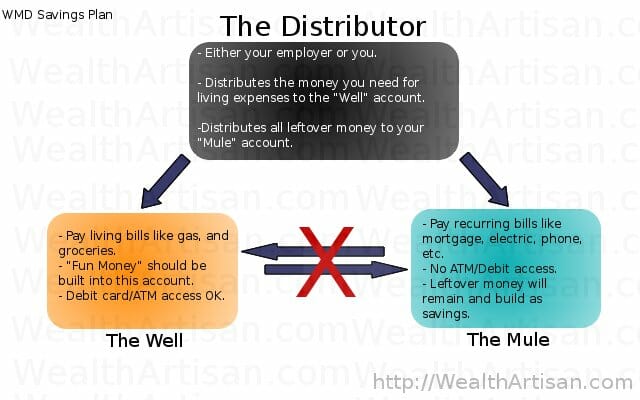We’ve begun discussing the WMD Savings method or plan. If you haven’t read it yet, be sure to read the Introduction to the WMD Savings Method. WMD stands for Well, Mule and Distributor. We continued the discussion on Friday with an explanation about the Well Account, its role, and how to plan for it properly.
Today, we are going to talk about the third and final piece of this plan, and that is the Mule account. In short, the Mule account is where your paycheck leftovers will end up. Preferably, this account will receive most of the money from your paycheck, and also have the most money left over.
The idea, is to allow the left over money to continue rolling over month after month, and gradually build into a savings.
What Is The Mule Account?
Now that you have a general understanding, we can go a bit more in-depth. The Mule account is the account that really handles the largest burden of your income. The largest, most income-consuming bills should be drafted out of it. Before we get ahead of ourselves, let us talk about how it gets funded, and how you decide what comes out.
The funding is the simplest part. Most of the planning goes into deciding how much to put into your Well Account, and the remainder should go in here. That sounds simple, but some people may realize that the portion going into this account is less than what goes into the well account. That could be an early indicator of a problem.
Ideally, the Mule account should get the largest portion of your paycheck because it should be paying for some of your bigger bills like:
- Mortgage/Rent
- Car Payments
- Insurance
- Electric, Water, Other Utilities
- The rest should build a savings.
Your Well Account is really just a day-to-day living account, and if that account is bigger than this one, then your quality of life may be far too high for your income. This is a very elementary perspective and your living situation will really dictate if this is a problem or not. For instance, if you have a living arrangement that provides free rent, utilities, and your car is paid off, then you probably don’t have a problem. Use common sense.
Why No Debit or ATM Access?
I put this in here for no reason other than to force you to control your consumption. Not having debit or ATM access requires you to initiate an electronic transfer. This can take a couple of days which will provide you some breathing room to really consider if you want to break your rules and spend the money in this account.
How Does The Money Go Into The Account?
This is done by your Distributor. The distributor puts the designated amount of money from your paycheck into your Well Account, and the remaining balance is put into this account. It’s very simple when automated by direct deposit!
How Do I Pay Bills Without Debit Access?
Simple, write a check, or establish an electronic monthly draft. Most companies allow you to auto debit your account directly. I prefer to write checks because it forces me to sit down and look at all of the numbers. This makes me face any wasteful or sloppy months head-on so I know what to do in the future to avoid them.
There’s Too Much Money Left Over After The Bills!
Good! That’s exactly the idea. Pretend this money doesn’t exist and continue letting it roll over and build. You’re now on your way to establishing savings! If you get too antsy, then consider putting some of the money into CDs or other investments that might better safely grow the money.
You can also consult with a financial advisor about investing it in other ways, but remember to keep an OK portion liquid in the even that you come upon hard times. Sometimes, it is better to just grow the money in the account first and establish your discipline.
There you have it, The Well, The Mule, and The Distributor. Those are the three pieces of a plan that I’ve developed, and used for well over two years now to cut my spending, watch my bills, budget better, and save more money than I could have any other way. I will be writing one more post about the WMD Savings Plan and it will be a “tying it all together post.”
This may not work for you, but there is only one way to find out! The only thing worse than a failed attempt is no attempt.
